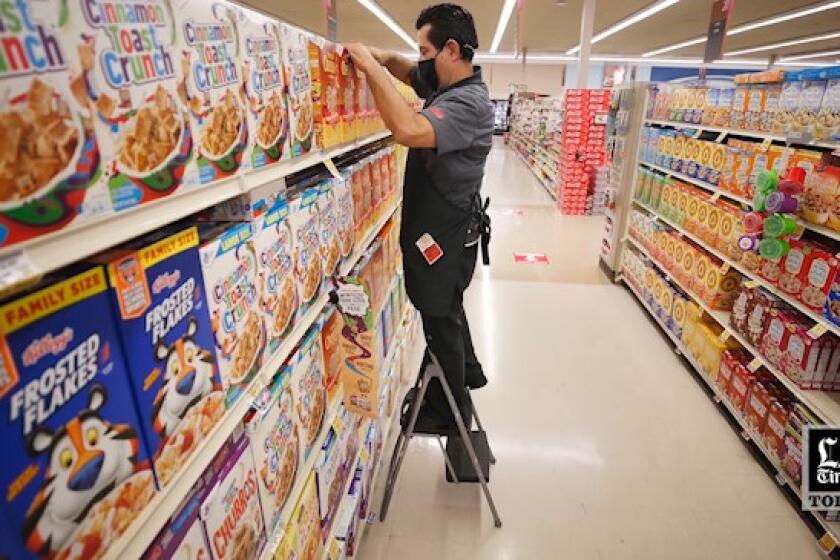Real Life Tests for Prop. 36
Three weeks after being among the first drug offenders in the state sentenced to treatment rather than time behind bars under Proposition 36, four defendants were scheduled to return before Los Angeles County Superior Court Judge Stephen Marcus this week to report their progress.
The results were mixed.
Two had enrolled in rehabilitation programs and seemed to be on the road to recovery. A third, who never reported for treatment, showed up in court six hours late and was temporarily taken into custody before being ordered by Marcus to return the next morning. The jury remains out on the fourth, who is in a rehabilitation program but did not come to the downtown Criminal Courts Building as scheduled.
Though the ballot measure was touted as a way to get drug offenders out of jail and into rehab centers, early evidence shows that some offenders are walking a precarious line between accepting the free help they need or landing right back behind bars.
“The reality is many addicts are not ready for treatment,” said Marcus in an interview. “The drug addiction is so strong and overwhelming in their life that it controls everything they do. They are simply going to go back to using drugs.”
If that proves to be the case, many defendants could swiftly end up in prison rather than in recovery. As a result, treatment centers might not be as overwhelmed as had been anticipated. And California voters--who passed the initiative by a 61-39% margin in November--could begin questioning the state’s innovative attempt to alter the way drug defendants are sentenced.
Proposition 36 targets defendants convicted of nonviolent drug crimes, including possession, use or transportation of drugs for personal use. Those who successfully finish their rehabilitation programs can ask the court to dismiss their drug charges.
Defendants in rehab programs who test positive for drugs or get caught with them generally have two chances to get back on track, but then can be sentenced to state prison. For defendants who don’t report to treatment programs, judges are issuing arrest warrants and considering sending them to prison immediately.
Marcus put out a warrant for missing defendant Christina Nixon at 10 a.m. Wednesday, an hour after she was due in court, but recalled it when she appeared at 3 p.m. That was a relief to Nixon, 43, who said she intended to go to treatment but just never made it. She said she also meant to come to court in the morning, but said it took her six hours to get up the courage and energy to face Marcus.
“I was scared ‘cause I knew I messed up,” she said. “I didn’t want that warrant. I don’t want to go to jail.”
Motivation Is Key to Effectiveness
The effectiveness of Proposition 36 largely depends on the motivation of people like Nixon, who has had several cocaine arrests in the last decade.
Unlike drug courts, judges have to place offenders in treatment under Proposition 36 regardless of the likelihood of success. As a result, judges don’t have high hopes: They estimate that 40% to 50% of defendants will never report to drug treatment facilities. They expect others to relapse, get rearrested or quit rehab programs.
Los Angeles County Superior Court Commissioner Ronald Rose said it’s a given that people are going to fail. “The real question is how many people will succeed,” he said.
Proposition 36 co-author Dave Fratello said he intended the initiative to make treatment an option for more drug offenders than were being chosen for drug courts. “Potentially savable cases were being tossed overboard,” he said. “Who knows whether someone is going to be successful or not? They may come into the courtroom looking like they have no motivation but they may find it in the course of a program.”
Nicholas Hernandez, 36, was first to be called Wednesday morning. As he watched the judge read a letter from his residential treatment program, Hernandez shifted his weight and rubbed his hands against his jeans. Marcus told him the report was positive.
Hernandez smiled and nodded, his dreadlocks bouncing. The Belize immigrant had been addicted to cocaine for 10 years and had been trying to give up drugs since a 1999 possession arrest. He relapsed four times.
“They kept giving me outpatient,” he said. “I needed inpatient. If I’m somewhere where I can get my head together, I might have a chance to be sober and clean.”
Marcus also praised Avenger quarterback Todd Marinovich for following his drug treatment plan at Impact, an outpatient program that includes counseling and random drug testing. Marinovich, who was convicted of heroin possession and has had previous drug problems, including a 1997 conviction for cultivating marijuana, said he was doing “excellent” in the program.
After asking the 32-year-old former Los Angeles Raider about his football season, Marcus wished him luck and said, “Just keep doing what you’re doing and hopefully this will be over in about a year.”
Misti Kerns, convicted of cocaine possession, did not come to court as scheduled Wednesday for her progress report. The court later in the day received a call from the inpatient treatment center where she is enrolled, saying residents can only be driven to court on Monday and Friday. So Marcus issued a $10,000 arrest warrant, but held it until this morning to give her a second chance to report to court.
When Nixon’s name was called, nobody answered. She had never reported to probation or to a treatment program and was nowhere to be found. So Marcus revoked her probation and issued a warrant. But late that afternoon, she came into the courtroom with excuses and apologies ready. She had no place to live, no money to pay for bus fare and no family to turn to for help, she said.
Marcus had his bailiff take her into custody, but then changed his mind and gave her another chance. He told her to come to court at 8:30 the next morning. Nixon, wearing gym shorts and a nose ring, ran into the courtroom Thursday morning out of breath and 25 minutes late.
Nixon said she had been in and out of prison for drugs and prostitution for five years when she got caught with cocaine recently. She knew Proposition 36 was a good opportunity for free rehab, but she said she just wasn’t ready three weeks ago.
“I had every intention of going,” she said. “But I thought my friends would be with me and I thought it was going to be easy. I’m very, very pleased to have a second chance. I’m ready to get over the hump.”
Marcus told her she escaped going to jail by an eyelash and ordered her to report for treatment immediately. “I am going to give you another opportunity,” he said. “All I can tell you is I’m going to be watching you.”
More to Read
Start your day right
Sign up for Essential California for news, features and recommendations from the L.A. Times and beyond in your inbox six days a week.
You may occasionally receive promotional content from the Los Angeles Times.






